Hematological and Clinical Features Associated with Initial Poor Treatment Outcomes in Visceral Leishmaniasis Patients with and without HIV Coinfection in Gondar, Northwest Ethiopia
Abstract
1. Introduction
2. Materials and Methods
2.1. Study Design and Setting
2.2. Inclusion and Exclusion Criteria
2.3. Data Collection and Analysis
2.4. Definitions and Reference (Normal) Values
3. Results
3.1. Demographic Characteristics
3.2. Baseline Laboratory Characteristics
3.3. Clinical Presentations of VL Patients with and without HIV Coinfection
3.4. Treatments and Predictors of Poor Treatment Outcomes among VL Patients with and without HIV Coinfection
4. Discussion
5. Conclusions
Author Contributions
Funding
Institutional Review Board Statement
Informed Consent Statement
Data Availability Statement
Acknowledgments
Conflicts of Interest
References
- Wamai, R.G.; Kahn, J.; Mcgloin, J.; Ziaggi, G. Visceral leishmaniasis: A global overview. J. Glob. Health Sci. 2020, 2, e3. [Google Scholar] [CrossRef]
- Chappuis, F.; Sundar, S.; Hailu, A.; Ghalib, H.; Rijal, S.; Peeling, R.W.; Alvar, J.; Boelaert, M. Visceral leishmaniasis: What are the needs for diagnosis, treatment and control ? Nat. Rev. Microbiol. 2007, 5, 873–882. [Google Scholar] [CrossRef]
- WHO. Leishmaniasis. 2022. Available online: https://www.who.int/news-room/fact-sheets/detail/leishmaniasis (accessed on 4 October 2022).
- Alvar, J.; Bashaye, S.; Argaw, D.; Cruz, I.; Aparicio, P.; Kassa, A.; Orfanos, G.; Parreño, F.; Babaniyi, O.; Gudeta, N.; et al. Kala-azar outbreak in Libo Kemkem, Ethiopia: Epidemiologic and parasitologic assessment. Am. J. Trop. Med. Hyg. 2007, 77, 275–282. [Google Scholar]
- Hailu, A.; Berhe, N.; Sisay, Z.; Abraham, I.; Medhin, G. Seroepidemiological and leishmanin skin test surveys of visceral leishmaniasis in south and southwest Ethiopia. Ethiop. Med. J. 1996, 34, 11–23. [Google Scholar]
- Alvar, J.; Vélez, I.D.; Bern, C.; Herrero, M.; Desjeux, P.; Cano, J.; Jannin, J.; den Boer, M. Leishmaniasis worldwide and global estimates of its incidence. PLoS ONE 2012, 7, e35671. [Google Scholar] [CrossRef]
- Leta, S.; Dao, T.H.T.; Mesele, F.; Alemayehu, G. Visceral leishmaniasis in Ethiopia: An evolving disease. PLoS Negl. Trop. Dis. 2014, 8, e3131. [Google Scholar] [CrossRef]
- Sharan, M.S.; Visceral, S. Leishmaniasis: Asymptomatic Facts: In Leishmaniasis-General Aspects of a Stigmatized Disease; Intechopen: London, UK, 2021; pp. 1–19. [Google Scholar] [CrossRef]
- Hailu, A.; Gramiccia, M.; Kager, P.A. Visceral leishmaniasis in Aba-Roba, south-western Ethiopia: Prevalence and incidence of active and subclinical infections. Ann. Trop. Med. Parasitol. 2009, 103, 659–670. [Google Scholar] [CrossRef]
- Singh, O.P.; Hasker, E.; Sacks, D.; Boelaert, M.; Sundar, S. Asymptomatic Leishmania infection: A new challenge for Leishmania control. Clin. Infect. Dis. Off. Publ. Infect. Dis. Soc. Am. 2014, 58, 1424–1429. [Google Scholar] [CrossRef]
- Anstead, G.M.; Chandrasekar, B.; Zhao, W.; Yang, J.; Perez, L.E.; Melby, P.C. Malnutrition alters the innate immune response and increases early visceralization following Leishmania donovani infection. Infect. Immun. 2001, 69, 4709–4718. [Google Scholar] [CrossRef]
- Van den Bergh, R.; Van Ginderachter, J.A.; Schouppe, E.; Desimmie, B.A.; Hailu, A.; De Baetselier, P.; van Griensven, J. Visceral leishmaniasis relapse in HIV patients--a role for myeloid-derived suppressor cells? PLoS Negl. Trop. Dis. 2014, 8, e3132. [Google Scholar] [CrossRef][Green Version]
- Mohebali, M.; Yimam, Y. Prevalence estimates of human immunodeficiency virus (HIV) infection among visceral leishmaniasis infected people in Northwest Ethiopia: A systematic review and meta-analysis. BMC Infect. Dis. 2020, 20, 214. [Google Scholar] [CrossRef]
- Kibret, G.D.; Ferede, A.; Leshargie, C.T.; Wagnew, F.; Ketema, D.B.; Alebel, A. Trends and spatial distributions of HIV prevalence in Ethiopia. Infect. Dis. Poverty 2019, 8, 90. [Google Scholar] [CrossRef]
- Van Griensven, J.; Carrillo, E.; Lopez-Velez, R.; Lynen, L.; Moreno, J. Leishmaniasis in immunosuppressed individuals. Clin. Microbiol. Infect. 2014, 20, 286–299. [Google Scholar] [CrossRef]
- Badaró, R.; Gonçalves, L.O.; Gois, L.L.; Pereira, Z.; Maia, G.; Benson, C.; Grassi, M.F.R. Leishmaniasis as a manifestation of immune reconstitution inflammatory syndrome (IRIS) in HIV-infected patients: A literature review. J. Int. Assoc. Provid. AIDS Care 2016, 14, 402–407. [Google Scholar] [CrossRef]
- Diro, E.; Lynen, L.; Mohammed, R.; Boelaert, M.; Hailu, A.; van Griensven, J. High parasitological failure rate of visceral leishmaniasis to sodium stibogluconate among HIV co-infected adults in Ethiopia. PLoS Negl. Trop. Dis. 2014, 8, e2875. [Google Scholar] [CrossRef]
- Diro, E.; Lynen, L.; Ritmeijer, K.; Boelaert, M.; Hailu, A.; Griensven, J. Van Visceral Leishmaniasis and HIV Coinfection in East Africa. PLoS Negl. Trop. Dis. 2014, 8, e2869. [Google Scholar] [CrossRef]
- Mohammed, R.; Fikre, H.; Schuster, A.; Mekonnen, T.; Van Griensven, J.; Diro, E. Multiple relapses of Visceral Leishmaniasis in HIV co-infected patients: A case series from Ethiopia. Curr. Ther. Res. 2020, 92, 100583. [Google Scholar] [CrossRef]
- Ter Horst, R.; Collin, S.M.; Ritmeijer, K.; Bogale, A.; Davidson, R.N. Concordant HIV infection and visceral leishmaniasis in Ethiopia: The influence of antiretroviral treatment and other factors on outcome. Clin. Infect. Dis. Off. Publ. Infect. Dis. Soc. Am. 2008, 46, 1702–1709. [Google Scholar] [CrossRef]
- Ritmeijer, K.; Dejenie, A.; Assefa, Y.; Hundie, T.B.; Mesure, J.; Boots, G.; Den Boer, M.; Davidson, R.N. HIV/AIDS a comparison of miltefosine and sodium stibogluconate for treatment of Visceral Leishmaniasis in an Ethiopian population with high prevalence of HIV infection. Clin. Infect. Dis. 2006, 43, 357–364. [Google Scholar] [CrossRef]
- Cloots, K.; Marino, P.; Burza, S.; Gill, N.; Boelaert, M.; Hasker, E. Visceral Leishmaniasis-HIV coinfection as a predictor of increased Leishmania transmission at the village level in Bihar, India. Front. Cell Infect. Microbiol. 2021, 11, 604117. [Google Scholar] [CrossRef]
- Lindoso, J.A.L.; Cunha, M.A.; Queiroz, I.T.; Moreira, C.H.V. Leishmaniasis–HIV coinfection: Current challenges. HIV/AIDS-Res. Palliat. Care 2016, 8, 147–156. [Google Scholar] [CrossRef]
- Federal Democratic Republic of Ethiopia National Nutrition Program 2016–2020. Published 2016, 88. Available online: www.unicef.org/ethiopia/National_Nutrition_Programme.pdf (accessed on 21 September 2022).
- Sinaga, M.; Worku, M.; Yemane, T.; Tegene, E.; Wakayo, T.; Girma, T.; Lindstrom, D.; Belachew, T. Optimal cut-off for obesity and markers of metabolic syndrome for Ethiopian adults. Nutr. J. 2018, 17, 109. [Google Scholar] [CrossRef]
- Welay, G.M.; Alene, K.A.; Dachew, B.A. Visceral leishmaniasis treatment outcome and its determinants in northwest Ethiopia. Epidemiol. Health 2016, 39, e2017001. [Google Scholar] [CrossRef]
- Burza, S.; Mahajan, R.; Sanz, M.G.; Sunyoto, T.; Kumar, R.; Mitra, G.; Lima, M.A. HIV and visceral leishmaniasis coinfection in Bihar, India: An underrecognized and underdiagnosed threat against elimination. Clin. Infect. Dis. Off. Publ. Infect. Dis. Soc. Am. 2014, 59, 552–555. [Google Scholar] [CrossRef]
- Cota, G.F.; de Sousa, M.R.; de Mendonca, A.L.P.; Patrocinio, A.; Assuncao, L.S.; de Faria, S.R.; Rabello, A. Leishmania-HIV co-infection: Clinical presentation and outcomes in an urban area in Brazil. PLoS Negl. Trop. Dis. 2014, 8, e2816. [Google Scholar] [CrossRef]
- Argaw, D.; Mulugeta, A.; Herrero, M.; Nombela, N.; Teklu, T.; Tefera, T.; Belew, Z.; Alvar, J.; Bern, C. Risk Factors for Visceral Leishmaniasis among Residents and Migrants in Kafta-Humera, Ethiopia. PLOS Neglected Trop. Dis. 2013, 7, e2543. [Google Scholar] [CrossRef]
- Gelanew, T.; Cruz, I.; Kuhls, K.; Alvar, J.; Cañavate, C.; Hailu, A.; Schönian, G. Multilocus microsatellite typing revealed high genetic variability of Leishmania donovani strains isolated during and after a Kala-azar epidemic in Libo Kemkem district, Northwest Ethiopia. Microbes Infect. 2011, 13, 595–601. [Google Scholar] [CrossRef]
- Worku, E.D.; Asemahagn, M.A.; Endalifer, M.L. Epidemiology of hiv infection in the amhara region of ethiopia, 2015 to 2018 surveillance data analysis. HIV/AIDS-Res. Palliat. Care 2020, 12, 307–314. [Google Scholar] [CrossRef]
- Hurissa, Z.; Gebre-Silassie, S.; Hailu, W.; Tefera, T.; Lalloo, D.G.; Cuevas, L.E.; Hailu, A. Clinical characteristics and treatment outcome of patients with visceral leishmaniasis and HIV co-infection in northwest Ethiopia. Trop. Med. Int. Health 2010, 15, 848–855. [Google Scholar] [CrossRef]
- Horrillo, L.; Castro, A.; Matía, B.; Molina, L.; García-Martínez, J.; Jaqueti, J.; García-Arata, I.; Carrillo, E.; Moreno, J.; Ruiz-Giardin, J.M.; et al. Clinical aspects of visceral leishmaniasis caused by L. infantum in adults. Ten years of experience of the largest outbreak in Europe: What have we learned? Parasites Vectors 2019, 12, 359. [Google Scholar] [CrossRef]
- Ritmeijer, K.; ter Horst, R.; Chane, S.; Aderie, E.M.; Piening, T.; Collin, S.M.; Davidson, R.N. Limited effectiveness of high-dose liposomal amphotericin B (AmBisome) for treatment of visceral leishmaniasis in an Ethiopian population with high HIV prevalence. Clin. Infect. Dis. Off. Publ. Infect. Dis. Soc. Am. 2011, 53, e152–e158. [Google Scholar] [CrossRef]
- Diro, E.; Blesson, S.; Edwards, T.; Ritmeijer, K.; Fikre, H.; Admassu, H.; Kibret, A.; Ellis, S.J.; Bardonneau, C.; Zijlstra, E.E.; et al. A randomized trial of AmBisome monotherapy and AmBisome and miltefosine combination to treat visceral leishmaniasis in HIV co-infected patients in Ethiopia. PLoS Negl. Trop. Dis. 2019, 13, e0006988. [Google Scholar] [CrossRef]
- Abongomera, C.; Diro, E.; de Lima Pereira, A.; Buyze, J.; Stille, K.; Ahmed, F.; van Griensven, J.; Ritmeijer, K. The initial effectiveness of liposomal amphotericin B (AmBisome) and miltefosine combination for treatment of visceral leishmaniasis in HIV co-infected patients in Ethiopia: A retrospective cohort study. PLoS Negl. Trop. Dis. 2018, 12, e6527. [Google Scholar] [CrossRef]
- Burza, S.; Mahajan, R.; Kazmi, S.; Alexander, N.; Kumar, D.; Kumar, V.; Lasry, E.; Harshana, A.; de Lima Pereira, A.; Das, P.; et al. AmBisome monotherapy and combination AmBisome–Miltefosine therapy for the treatment of Visceral Leishmaniasis in patients coinfected with Human Immunodeficiency Virus (HIV) in India: A randomized open-label, parallel-arm, phase 3 trial. Clin. Infect. Dis. 2022, 75, 1423–1432. [Google Scholar] [CrossRef]
- Alvar, J.; Aparicio, P.; Aseffa, A.; Den Boer, M.; Cañavate, C.; Dedet, J.-P.; Gradoni, L.; Ter Horst, R.; Loópez-Veólez, R.; Moreno, J. The Relationship between Leishmaniasis and AIDS: The Second 10 Years. Clin. Microbiol. Rev. 2008, 21, 334–359. [Google Scholar] [CrossRef]
- Burza, S.; Mahajan, R.; Sinha, P.K.; Van Griensven, J.; Pandey, K.; Lima, M.A.; Sanz, M.G.; Sunyoto, T.; Kumar, S.; Mitra, G.; et al. Visceral Leishmaniasis and HIV Co-infection in Bihar, India: Long-term Effectiveness and Treatment Outcomes with Liposomal Amphotericin B (AmBisome). PLOS Negl. Trop. Dis. 2014, 8, e3053. [Google Scholar] [CrossRef]
- Ministry of Health Guideline for Diagnosis, Treatment & Prevention of Leishmaniasis in Ethiopia. 2013. Available online: http://repository.iifphc.org/handle/123456789/445 (accessed on 6 October 2022).
- Musa, A.; Khalil, E.; Hailu, A.; Olobo, J.; Balasegaram, M.; Omollo, R.; Edwards, T.; Rashid, J.; Mbui, J.; Musa, B.; et al. Sodium stibogluconate (ssg) & paromomycin combination compared to ssg for visceral leishmaniasis in east africa: A randomised controlled trial. PLoS Negl. Trop. Dis. 2012, 6, e1674. [Google Scholar] [CrossRef]
- Kimutai, R.; Musa, A.M.; Njoroge, S.; Omollo, R.; Alves, F.; Hailu, A.; Khalil, E.A.G.; Diro, E.; Soipei, P.; Musa, B.; et al. Safety and effectiveness of sodium stibogluconate and paromomycin combination for the treatment of Visceral Leishmaniasis in Eastern Africa: Results from a pharmacovigilance programme. Clin. Drug Investig. 2017, 37, 259–272. [Google Scholar] [CrossRef]
- Abongomera, C.; Gatluak, F.; Buyze, J.; Ritmeijer, K. A comparison of the effectiveness of sodium stibogluconate monotherapy to sodium stibogluconate and paromomycin combination for the treatment of severe post kala azar dermal leishmaniasis in south Sudan-A retrospective cohort study. PLoS ONE 2016, 11, e163047. [Google Scholar] [CrossRef]
- Atia, A.M.; Mumina, A.; Tayler-Smith, K.; Boulle, P.; Alcoba, G.; Elhag, M.S.; Alnour, M.; Shah, S.; Chappuis, F.; Griensven, J.; et al. Sodium stibogluconate and paromomycin for treating visceral leishmaniasis under routine conditions in eastern Sudan. Trop. Med. Int. Health 2015, 20, 1674–1684. [Google Scholar] [CrossRef]
- Tamiru, A.; Mohammed, R.; Atnafu, S.; Medhin, G.; Hailu, A. Efficacy and safety of a combined treatment of sodium stibogluconate at 20mg/kg/day with upper maximum daily dose limit of 850mg and Paromomycin 15mg/kg/day in HIV negative visceral leishmaniasis patients. A retrospective study, northwest Ethiopia. PLoS Negl. Trop. Dis. 2021, 15, e0009713. [Google Scholar] [CrossRef]
- Tamiru, A.; Tigabu, B.; Yifru, S.; Diro, E.; Hailu, A. Safety and efficacy of liposomal amphotericin B for treatment of complicated visceral leishmaniasis in patients without HIV, North-West Ethiopia. BMC Infect. Dis. 2016, 16, 548. [Google Scholar] [CrossRef]
- Oliveira-Sena, I.V.; Werneck, G.L. Risk factors for in-hospital mortality from visceral leishmaniasis: A case-control study. J. Infect. Public Health 2020, 13, 538–543. [Google Scholar] [CrossRef]
- Yeshaw, Y.; Tsegaye, A.T.; Nigatu, S.G. Incidence of Mortality and Its Predictors Among Adult Visceral Leishmaniasis Patients at the University of Gondar Hospital: A Retrospective Cohort Study. Infect. Drug Resist. 2020, 13, 881–891. [Google Scholar] [CrossRef]
- Lyons, S.; Veeken, H.; Long, J. Visceral leishmaniasis and HIV in Tigray, Ethiopia. Trop. Med. Int. Health 2003, 8, 733–739. [Google Scholar] [CrossRef]
- Kämink, S.S.; Collin, S.M.; Harrison, T.; Gatluak, F.; Mullahzada, A.W.; Ritmeijer, K. A clinical severity scoring system for visceral leishmaniasis in immunocompetent patients in South Sudan. PLoS Negl. Trop. Dis. 2017, 11, e5921. [Google Scholar] [CrossRef]
- Mueller, Y.; Mbulamberi, D.B.; Odermatt, P.; Hoffmann, A.; Loutan, L.; Chappuis, F. Risk factors for in-hospital mortality of visceral leishmaniasis patients in eastern Uganda. Trop. Med. Int. Health 2009, 14, 910–917. [Google Scholar] [CrossRef]
- Gebreyohannes, E.A.; Bhagvathula, A.S.; Abegaz, T.M.; Seid, M.A. Treatment outcomes of visceral leishmaniasis in Ethiopia from 2001 to 2017: A systematic review and meta-analysis. Infect. Dis. Poverty 2018, 7, 108. [Google Scholar] [CrossRef]
- Abongomera, C.; van Henten, S.; Vogt, F.; Buyze, J.; Verdonck, K.; van Griensven, J. Prognostic factors for mortality among patients with visceral leishmaniasis in East Africa: Systematic review and meta-analysis. PLoS Negl. Trop. Dis. 2020, 14, e8319. [Google Scholar] [CrossRef]
- Belo, V.S.; Struchiner, C.; Barbosa, D.S.; Nascimento, B.W.L.; Horta, M.A.P.; Da Silva, E.S.; Werneck, G.L. Risk factors for adverse prognosis and death in American Visceral Leishmaniasis: A meta-analysis. PLoS Negl. Trop. Dis. 2014, 8, e2982. [Google Scholar] [CrossRef]
- De Queiroz Sampaio, M.J.A.; Cavalcanti, N.V.; Alves, J.G.B.; Filho, M.J.C.F.; Correia, J.B. Risk factors for death in children with visceral leishmaniasis. PLoS Negl. Trop. Dis. 2010, 4, e877. [Google Scholar] [CrossRef]
- Daher, E.D.F.; Soares, D.D.S.; Filho, S.L.A.P.; Meneses, G.C.; Freitas, T.V.D.S.; Leite, T.T.; Junior, G.B.D.S. Hyponatremia and risk factors for death in human visceral leishmaniasis: New insights from a cross-sectional study in Brazil. BMC Infect. Dis. 2017, 17, 168. [Google Scholar] [CrossRef]
- Chufal, S.S.; Pant, P.; Chachra, U.; Singh, P.; Thapliyal, N.; Rawat, V. Role of haematological changes in predicting occurrence of Leishmaniasis- A study in Kumaon region of Uttarakhand. J. Clin. Diagnostic Res. 2016, 10, EC39–EC43. [Google Scholar] [CrossRef]
- Tarekegn, B.; Tamene, A. Clinical and laboratory profiles of visceral leishmaniasis among adult patients admitted to Felege Hiwot Hospital, Bahir Dar, Ethiopia. SAGE Open Med. 2021, 9, 1–6. [Google Scholar] [CrossRef]
- Shiferaw, E.; Murad, F.; Tigabie, M.; Abebaw, M.; Alemu, T.; Abate, S.; Mohammed, R.; Yeshanew, A.; Tajebe, F. Hematological profiles of visceral leishmaniasis patients before and after treatment of anti-leishmanial drugs at University of Gondar Hospital; Leishmania Research and Treatment Center Northwest, Ethiopia. BMC Infect. Dis. 2021, 21, 1005. [Google Scholar] [CrossRef]
- Berhe, N.; Hailu, A.; Abraham, Y.; Tadesse, Y.; Breivik, K.; Abebe, Y. Inter-current and nosocomial infections among visceral leishmaniasis patients in Ethiopia: An observational study. Acta Trop. 2001, 80, 87–95. [Google Scholar] [CrossRef]
- Endris, M.; Takele, Y.; Woldeyohannes, D.; Tiruneh, M.; Mohammed, R.; Moges, F.; Lynen, L.; Jacobs, J.; van Griensven, J.; Diro, E. Bacterial sepsis in patients with visceral leishmaniasis in Northwest Ethiopia. Biomed Res. Int. 2014, 2014, 361058. [Google Scholar] [CrossRef]
- Madalosso, G.; Fortaleza, C.M.; Ribeiro, A.F.; Cruz, L.L.; Nogueira, P.A.; Lindoso, J.A.L. American visceral leishmaniasis: Factors associated with lethality in the state of são paulo, Brazil. J. Trop. Med. 2012, 2012, 281572. [Google Scholar] [CrossRef]
- Santos-Oliveira, J.R.; Regis, E.G.; LealCá, C.R.B.; Cunha, R.V.; BozzaPatrí, P.T.; Da-Cruz, A.M. Evidence that lipopolisaccharide may contribute to the cytokine storm and cellular activation in patients with visceral leishmaniasis. PLoS Negl. Trop. Dis. 2011, 5, e1198. [Google Scholar] [CrossRef]
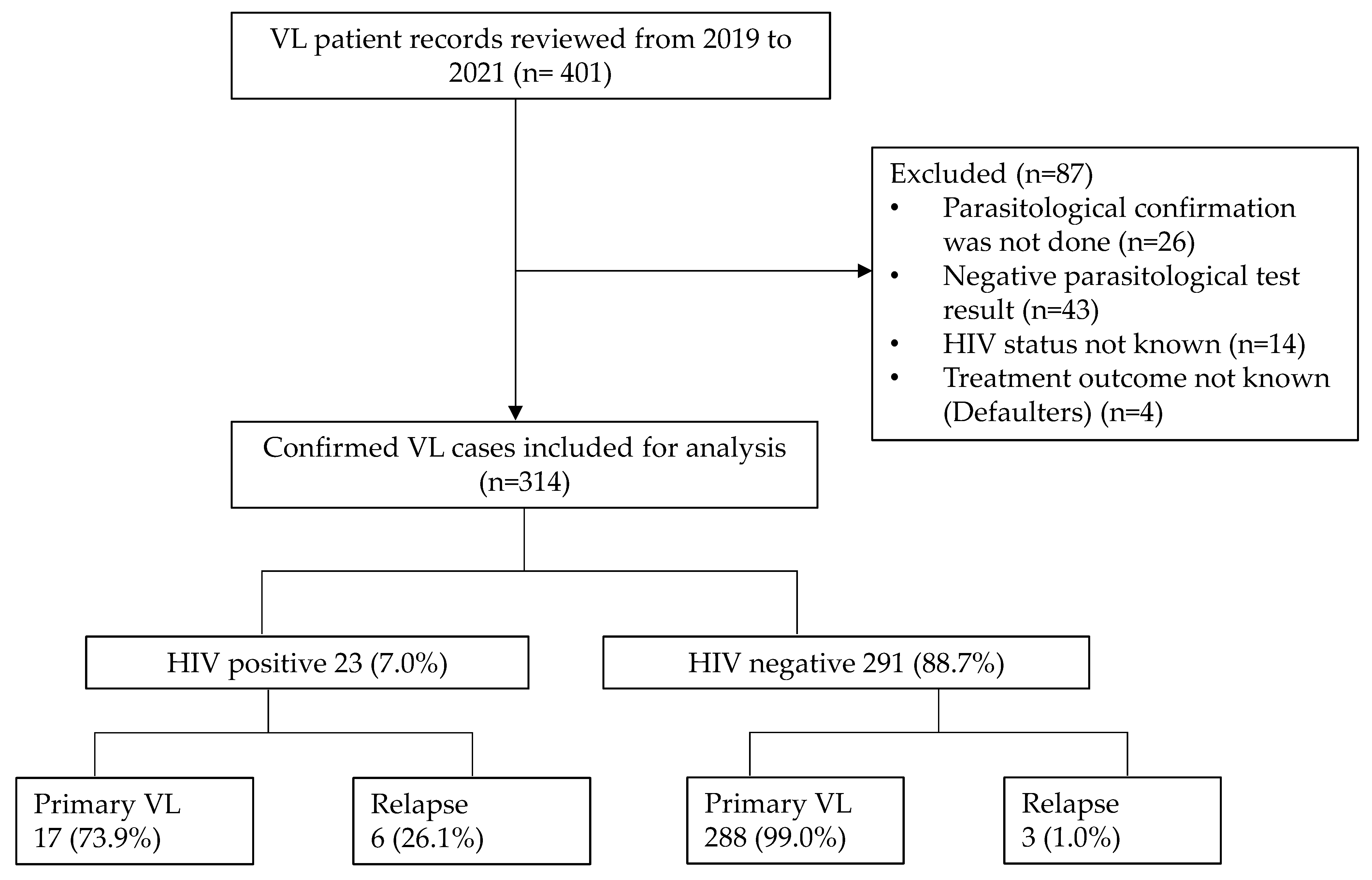
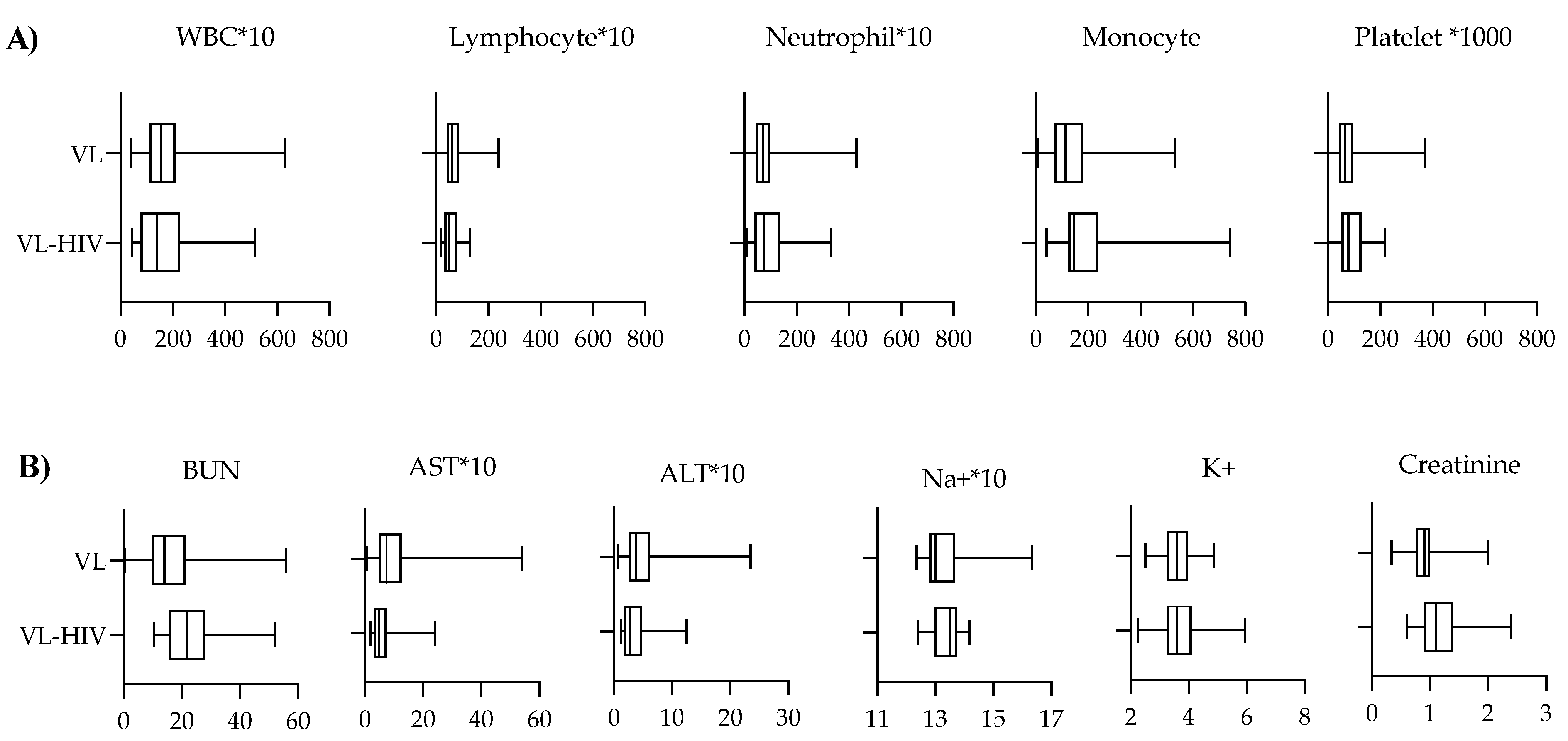
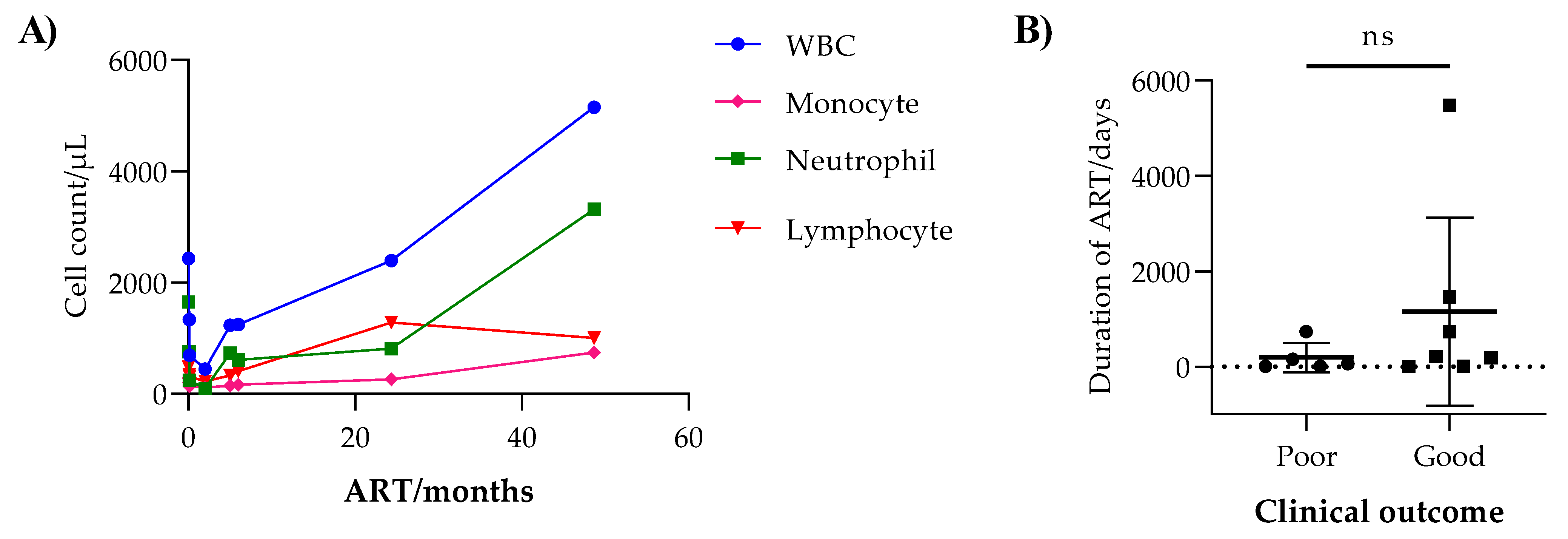
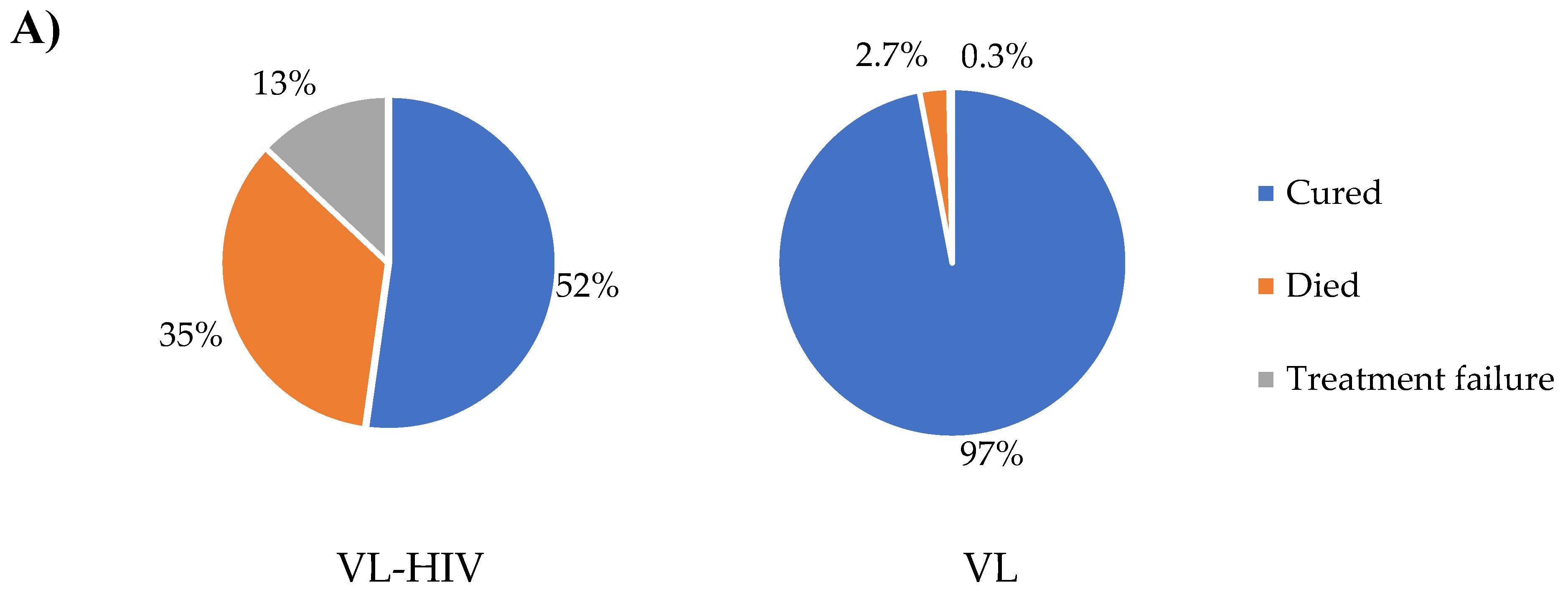
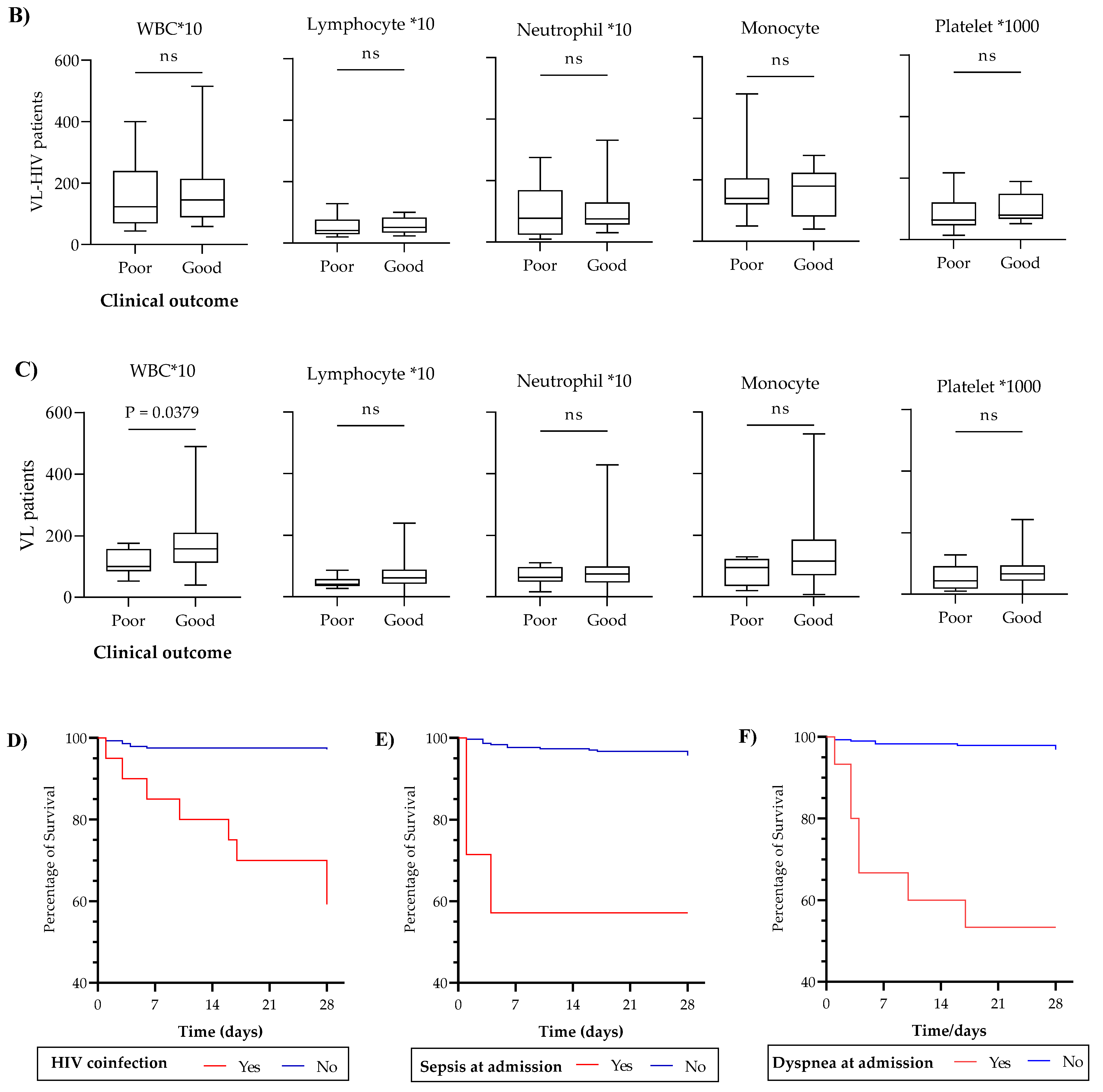
| VL–HIV, n = 23 | VL, n = 291 | |
|---|---|---|
| Sex (male/female) | 23:0 | 288:3 |
| Age in years (mean ± SD) | 35.30 ± 9.79 | 24.37 ± 7.16 |
| Residence (rural/urban) | 23:0 | 275:16 |
| Ethnic group (Amhara/other) | 23:0 | 290:1 |
| Marital status (married/unmarried) | 1:22 | 19:272 |
| Duration of illness, days (mean ± SD) | 62.26 ± 44.28 | 39.09 ± 29.83 |
| Duration of illness >2 months (n, %) | 9 (39.1%) | 33 (11.3%) |
| Relapse (n, %) | 6 (26.1%) | 3 (1.0%) |
| PG in spleen (median, IQR) | 5 (3) | 2 (2) |
| Spleen PG ≥ 4 (n, %) | 13 (72.2%) | 58 (24.0%) |
| Spleen size (mean ± SD) | 7.26 ± 3.25 | 8.50 ± 3.95 |
| Liver size (mean ± SD) | 3.50 ± 1.24 | 3.86 ± 1.65 |
| Leucopenia (n, %) | 20/23 (87.0%) | 276/291 (94.8%) |
| Lymphocytopenia (n, %) | 20/21 (95.2%) | 225/273 (82.4%) |
| Neutropenia (n, %) | 16/20 (80.0%) | 246/268 (91.8%) |
| Monocytosis (n, %) | 1/18 (5.6%) | 0/218 (0.00%) |
| Anemia (n, %) | 21 (91.3%) | 247/289 (85.5%) |
| Thrombocytopenia (n, %) | 17/22 (77.3%) | 252/287 (87.8%) |
| VL–HIV (n, %), n = 23 | VL (n, %), n = 291 | |
|---|---|---|
| Clinical presentations | ||
| Fever lasting more than 2 weeks | 18 (78.3%) | 286 (98.3%) |
| Abdominal pain | 7 (30.4%) | 85 (29.2%) |
| Abdominal swelling | 10 (43.5%) | 152 (52.2%) |
| Diarrhea | 10 (43.5%) | 49 (16.8%) |
| Cough | 16 (69.6%) | 166 (57.0%) |
| Jaundice | 1 (4.3%) | 50 (17.2%) |
| Pallor | 3 (13.0%) | 84 (28.9%) |
| Lymphadenopathy | 3 (13.0%) | 11 (3.8%) |
| Splenomegaly | 23 (100.0%) | 284 (97.6%) |
| Hepatomegaly | 12 (52.2%) | 119 (40.9%) |
| Weakness | 1 (4.3%) | 15 (5.2%) |
| Weight loss | 16 (69.6%) | 105 (36.1%) |
| Anorexia | 17 (73.9%) | 115 (39.5%) |
| Oedema | 3 (13.0%) | 78 (26.8%) |
| Joint pains | 1 (4.3%) | 10 (3.4%) |
| Dyspnea | 5 (21.7%) | 11 (3.8%) |
| Easily fatigable | 8 (34.8%) | 86 (29.6%) |
| Epistaxis | 1 (4.3%) | 16 (5.5%) |
| Vomiting | 1 (4.3%) | 10 (3.4%) |
| Malnutrition | 22 (95.7%) | 224/265 (84.5%) |
| Severe malnutrition | 11/22 (50.0%) | 67/224 (29.9%) |
| Underlying medical conditions | ||
| Intestinal Parasite | 6 (26.1%) | 63 (21.6%) |
| Malaria | 1 (4.3%) | |
| Pneumonia | 10 (43.5%) | 52 (17.9%) |
| Tuberculosis | 5 (21.7%) | 11 (3.8%) |
| Sepsis | 0 (0.0%) | 7 (2.4%) |
| Urinary tract infections | 0 (0.0%) | 15 (5.2%) |
| COVID-19 | 1 (4.3%) | 0 (0.0%) |
| Diabetes mellitus | 0 (0.0%) | 1 (0.3%) |
| Acute Kidney Injury | 2 (8.7%) | 2 (0.7%) |
| HBV infection | 0 (0.0%) | 3 (1.0%) |
| HCV infection | 0 (0.0%) | 5 (1.7%) |
| Acute gastro enteritis | 1 (4.3%) | 8 (2.7%) |
| Hyper-reactive malarial splenomegaly | 0 (0.0%) | 8 (2.7%) |
| Asthma | 0 (0.0%) | 1 (0.3%) |
| Hematological data | ||
| WBC count (mean ± SD) | 1745.65 ± 1215.67 | 1677.35 ± 814.57 |
| Lymphocyte count (mean ± SD) | 555.56 ± 293.43 | 705.31 ± 363.10 |
| Neutrophil count (mean ± SD) | 1044.32 ± 888.16 | 836.91 ± 493.23 |
| Monocyte count (mean ± SD) | 202.33 ± 168.48 | 140.23 ± 90.36 |
| Mixed cell count (mean ± SD) | 405.25 ± 134.00 | 186.95 ± 179.35 |
| Hgb, g/dL (mean ±SD) | 8.60 ± 2.20 | 8.69 ± 2.12 |
| Platelet, count × 103/μL (mean ± SD) | 96.36 ± 55.78 | 75.09 ± 45.83 |
| BUN, mg/dL (mean ± SD) | 24.28 ± 10.91 | 17.75 ± 14.55 |
| AST, IU/L (mean ± SD) | 63.30 ± 52.80 | 109.25 ± 104.69 |
| ALT, IU/L (mean ± SD) | 35.05 ± 27.31 | 60.30 ± 69.37 |
| Na, mEq/L (mean ± SD) | 134.18 ± 5.20 | 133.18 ± 7.97 |
| K, mEq/L (mean ± SD) | 3.68 ± 0.86 | 3.65 ± 0.61 |
| Creatinine, mg/dL (mean ± SD) | 1.20 ± 0.47 | 1.83 ± 7.26 |
| Poor Outcome, n (%) | Good Outcome, n (%) | COR (95% CI) | AOR (95% CI) | |
|---|---|---|---|---|
| Sepsis | 3 (15.0%) | 4/294 (1.4%) | 13 (2.65, 61.79) | 14 (1.55, 126.51) |
| HIV | 11/20 (55.0%) | 12/294 (4.1%) | 29 (10.02, 82.36) | 32 (8.45, 122.95) |
| Dyspnea | 8/20 (40.0%) | 8/294 (2.7%) | 24 (7.64, 74.34) | 18 (3.65, 87.40) |
| Hepatomegaly | 13 (65.0%) | 118 (40.1%) | 3 (1.07, 7.15) | |
| Anorexia | 14 (70.0%) | 118 (40.1%) | 3 (1.30, 9.31) |
Disclaimer/Publisher’s Note: The statements, opinions and data contained in all publications are solely those of the individual author(s) and contributor(s) and not of MDPI and/or the editor(s). MDPI and/or the editor(s) disclaim responsibility for any injury to people or property resulting from any ideas, methods, instructions or products referred to in the content. |
© 2023 by the authors. Licensee MDPI, Basel, Switzerland. This article is an open access article distributed under the terms and conditions of the Creative Commons Attribution (CC BY) license (https://creativecommons.org/licenses/by/4.0/).
Share and Cite
Ademe, M.; Osorio, Y.; Howe, R.; Atnafu, S.; Mulaw, T.; Fikre, H.; Travi, B.L.; Hailu, A.; Melby, P.C.; Abebe, T. Hematological and Clinical Features Associated with Initial Poor Treatment Outcomes in Visceral Leishmaniasis Patients with and without HIV Coinfection in Gondar, Northwest Ethiopia. Trop. Med. Infect. Dis. 2023, 8, 36. https://doi.org/10.3390/tropicalmed8010036
Ademe M, Osorio Y, Howe R, Atnafu S, Mulaw T, Fikre H, Travi BL, Hailu A, Melby PC, Abebe T. Hematological and Clinical Features Associated with Initial Poor Treatment Outcomes in Visceral Leishmaniasis Patients with and without HIV Coinfection in Gondar, Northwest Ethiopia. Tropical Medicine and Infectious Disease. 2023; 8(1):36. https://doi.org/10.3390/tropicalmed8010036
Chicago/Turabian StyleAdeme, Muluneh, Yaneth Osorio, Rawliegh Howe, Saba Atnafu, Tadele Mulaw, Helina Fikre, Bruno L. Travi, Asrat Hailu, Peter C. Melby, and Tamrat Abebe. 2023. "Hematological and Clinical Features Associated with Initial Poor Treatment Outcomes in Visceral Leishmaniasis Patients with and without HIV Coinfection in Gondar, Northwest Ethiopia" Tropical Medicine and Infectious Disease 8, no. 1: 36. https://doi.org/10.3390/tropicalmed8010036
APA StyleAdeme, M., Osorio, Y., Howe, R., Atnafu, S., Mulaw, T., Fikre, H., Travi, B. L., Hailu, A., Melby, P. C., & Abebe, T. (2023). Hematological and Clinical Features Associated with Initial Poor Treatment Outcomes in Visceral Leishmaniasis Patients with and without HIV Coinfection in Gondar, Northwest Ethiopia. Tropical Medicine and Infectious Disease, 8(1), 36. https://doi.org/10.3390/tropicalmed8010036





